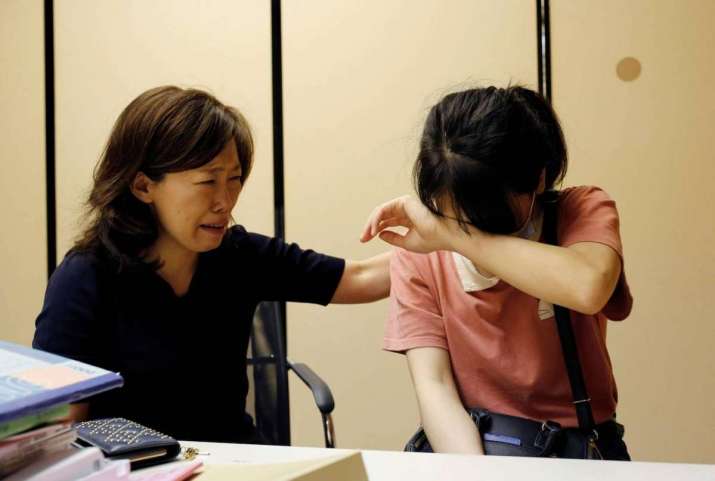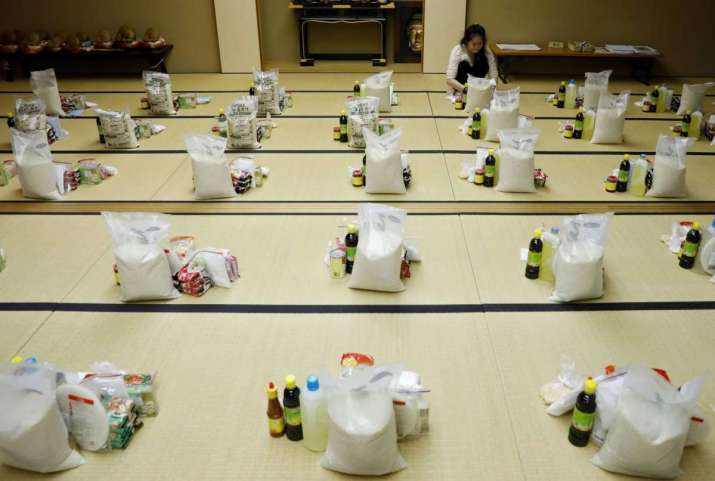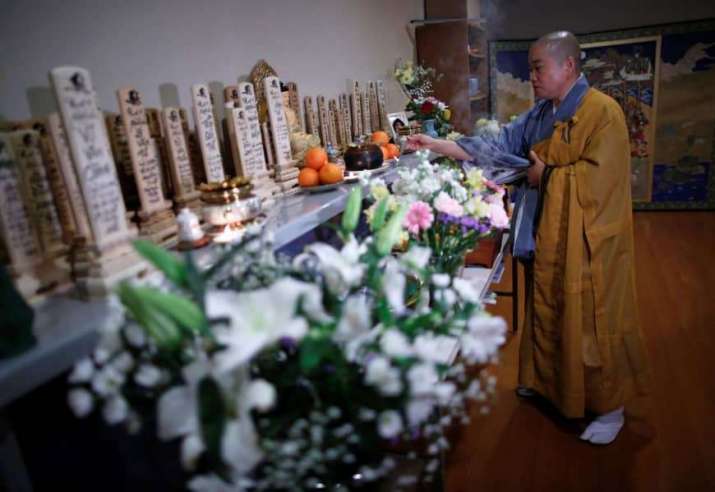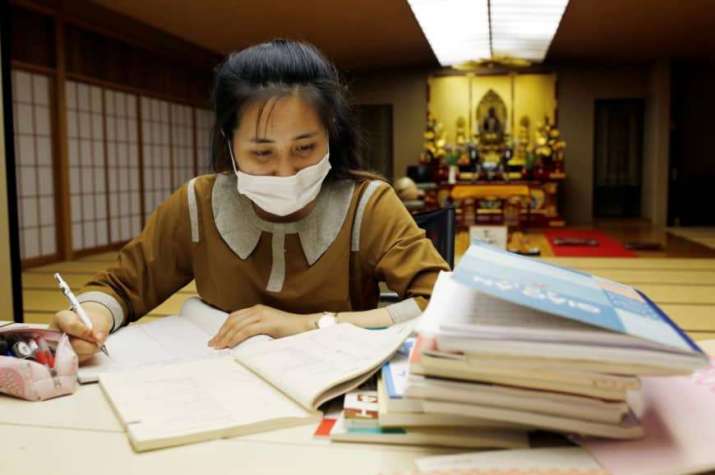NEWS
Buddhist Temple in Tokyo Offers Vietnamese Workers Refuge from the Pandemic
 Jiho Yoshimizu cries as she comforts Vietnamese worker Thi Tu Luong, who has sought help at Nissinkutu Buddhist temple in Tokyo. From japantimes.co.jp
Jiho Yoshimizu cries as she comforts Vietnamese worker Thi Tu Luong, who has sought help at Nissinkutu Buddhist temple in Tokyo. From japantimes.co.jpNissinkutu, a three-floor Buddhist temple in Tokyo’s Minato Ward, has become a refuge for expatriate Vietnamese workers, one of the communities to have been hardest-hit by the economic slump that has followed in the wake of the novel coronavirus outbreak in Japan.
Within the temple, young Vietnamese whose lives in Japan have been upturned by the repercussions of the COVID-19 pandemic, have sought shelter after being laid off from their jobs. Nissinkutu offers a sense of stability and peace amid fear and uncertainty for migrant workers who have nowhere else to turn, and a chance to look for new work or book a flight home.
Japan has to date reported 26,767 confirmed cases of COVID-19 and 988 deaths, with 20,001 people reported to have recovered.*
Nissinkutu is affiliated with the Jōdo-shū school of Japanese Pure Land Buddhism, founded in 1175 by the religious reformer and monk Hōnen (1133–1212) and centered on the teachings of the Infinite Life Sutra. The temple first became a contact point for the Vietnamese community in Japan after offering shelter to homeless Vietnamese workers following the devastating 2011 earthquake and tsunami in northern Japan. Now the nuns at the temple spend much of their time making care packages for Vietnamese across the country.
“We do everything. We take care of people from when they’re inside the womb to when they’re inside an urn,” said Jiho Yoshimizu, who runs a non-profit organization from the temple—the Japan-Vietnam Coexistence Support Group—dealing with everything from helping workers who have lost their jobs, or who are fleeing abusive employers, to helping pregnant women seeking abortions. (The Japan Times)
 A Vietnamese worker who lost her job because of the COVID-19 pandemic prepares welfare packages for Vietnamese people in Japan. From japantimes.co.jp
A Vietnamese worker who lost her job because of the COVID-19 pandemic prepares welfare packages for Vietnamese people in Japan. From japantimes.co.jpDrawn to Japan by the prospect of increased earnings, migrant workers from Vietnam often find themselves heavily in debt to unscrupulous recruitment agencies that charge high service fees, and vulnerable to exploitation and overwork at the hands of employers.
The Reuters news agency reported that Japan’s expatriate Vietnamese community numbered some 410,000 in 2019, an increase of almost 25 per cent on the previous year, and up from an official figure of 262,405 in 2017. The rapid growth has been fueled by a desire for better economic opportunities among Vietnamese and Japanese government efforts to address Japan’s historic labor shortage for blue-collar workers.
An altar in Nissinkutu is lined with rows of wooden mortuary tablets bearing the names of scores of Vietnamese nationals who have died after coming to Japan as students or under technical training programs that offer a route to blue-collar work. The tablets also include the names of unborn infants, either miscarried or aborted.
Yoshimizu’s non-profit dealt with some 400 individual cases in 2019. Since April this year, she said, anywhere from 10–20 appeals for assistance are received daily from Vietnamese nationals across the country, along with messages from employment agencies and employers.
“No one else in Japan right now can provide this kind of support,” Yoshimizu said. (The Japan Times)
 Vietnamese Buddhist nun Thich Tam Tri offers incense at an altar in Nissinkutu. Before her are rows of wooden tablets bearing the names of Vietnamese students and workers who died in Japan. From japantimes.co.jp
Vietnamese Buddhist nun Thich Tam Tri offers incense at an altar in Nissinkutu. Before her are rows of wooden tablets bearing the names of Vietnamese students and workers who died in Japan. From japantimes.co.jpTwenty-two-year-old Thi Tu Luong is just one of many Vietnamese nationals to arrive at the temple in dire straits. She has found her way to Nissinkutu earlier in June after being fired from a service job at a high-end hotel in Nikko—a city to the north of Tokyo famed for its hot springs and Buddhist temples—after the pandemic laid waste to the tourism industry.
After graduating from a vocational school in March and starting work at the hotel in mid-April, Luong said she wasn’t given any work, but instead spent her days in a dormitory room. Luong said she was paid ¥30,000 (US$280) in May, but was uncertain whether she had received any wages for June.
“I felt abandoned,” said Luong, after finding a measure of refuge and respite at the temple. “I’m just really grateful I can be here.” (The Japan Times)
At the time of writing on 22 July, global confirmed COVID-19 infections were reported to have reached just under 15 million, with 616,769 deaths so far recorded and 8.5 million recovered.* The World Health Organization in March estimated the mortality rate from the SARS-CoV-2 coronavirus, believed to have originated in Wuhan, China, at 3–4 per cent, based on incomplete and preliminary data, with the elderly and people with underlying health conditions considered most at risk. More recent data suggests that the mortality rate may be significantly lower, however studies are inconclusive due to variations in COVID-19 testing procedures in different countries, and differing methodologies for classifying and reporting COVID-19 as a cause of death.
 A Vietnamese worker who lost her job amid the coronavirus outbreak studies Japanese at Nissinkutu. From japantimes.co.jp
A Vietnamese worker who lost her job amid the coronavirus outbreak studies Japanese at Nissinkutu. From japantimes.co.jpBuddhism and Shinto are the two most widespread religious traditions in modern Japan, with 79.2 per cent of the population identifying as practicing Shinto and 66.8 per cent identifying as Buddhists, indicating a high level of overlap between the two traditions, although, somewhat paradoxically, a majority of Japanese also identify as atheists for a number of cultural reasons. Christians represent 1.5 per cent of the population, while other religions make up a combined 7.1 per cent, according to data for 2017. The most popular schools of Buddhism are Nichiren, Pure Land, Shingon, and Zen.
See more
A Tokyo temple offers pandemic-hit Vietnamese workers a safe haven (The Japan Times)
Vietnamese nun in Tokyo prays for compatriots who lost lives at work in Japan, fearing more to come (The Japan Times)
Death of 174 Trainees working long hours with debts (Tokyo Migrants’ Desk)
Young Vietnamese interns and students remembered in Japan (Asia Times)
Nissinkutu
Related news from Buddhistdoor Global
Buddhist Funerals in Japan See Fewer Mourners and Delays in Response to the Coronavirus
Soka Gakkai President Calls for Support on Nuclear Disarmament and Youth Climate Action
1,600 Women Join 400-year-old Archery Tournament at Kyoto Buddhist Temple
German-born Buddhist Monk Passes 1,000-year-old Monastic Exam in Japan
Japanese Buddhist Temples Share Devotional Offerings with Disadvantaged Families
See all coronavirus-related content from Buddhistdoor Global














